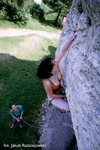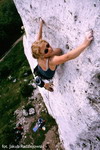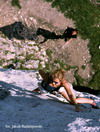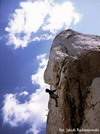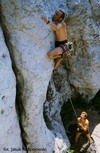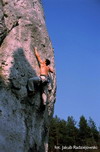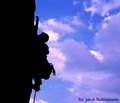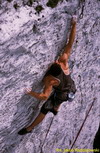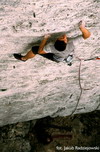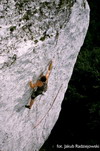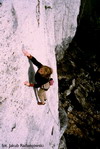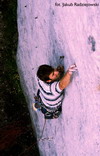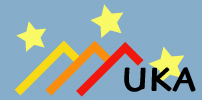
| nowości forum klub ścianka kurs sekcja juniorów teksty topo galerie linki Łukasz Wajs english |
| Jura |
| Kamieniec |
| Morskie Oko |
Jura
author: Agnieszka Romańska, Grzegorz Zieliński [www.wspinek.fr.pl]
translation: Agnieszka Romańska, Kamil Weinberg
photographs: Jakub RadziejowskiGeological description
The area of Jura Krakowsko-Częstochowska is divided into the northern and southern parts, but this is just a conventional division for climbers' needs. The northern part is larger and includes the Częstochowska Highland and the Smoleńsko-Niegowonickie Hills. Some rocks are isolated and others form large groups on hills (e.g. Zborów Hill, Rzędkowice Rocks, Podzamcze Rocks). The southern part includes highlands around Kraków, where rocks appear on slopes of valleys (Kobylańaska Valley, Będkowska Valley, Bolechowicka Valley and others) and on tops of plateaus (e.g. near Jerzmanowice). Climbers also explore abandoned quarries in and near Kraków (Krzemionki, Zakrzówek).
From the climbers' point of view we can distinguish the following rock areas of Jura Krakowsko-Częstochowska:
Northern Jura:
- Climbing regions near Częstochowa:
- Mirów (near Częstochowa)
- Zielona Mount
- Towarne Mountains
- Olsztyn
- Sokole Mountains
- Suliszowie and Zaborze
- Wiercica Valley
- Trzebniów
- Mirów and Bobolice
- Kroczyce
- Podlesice
- Rzędkowice
- Morsko
- Skarżyce
- Karlina
- Podzamcze
- Climbing regions near Smoleń and Niegowonice:
- Udorki Valley
- Smoleń and Strzegowa
- Złożeniec
- Ryczów
- Niegowonice
- Kluczów
- Jaroszowieckie
- Rabsztyna
Southern Jura:
- Rocks near Przeginia, Szklary and Jerzmanowice
- Podkrakowskie valleys:
- Dłubnia Valley
- Prądnik and Sąpsówka Valley
- Wierzchowska Valley
- Bolechowicka Valley
- Kobylańska Valley
- Będkowska Valley
- Szklarka Valley
- Racławka Valley
- Quarry in Dębnik
- Tenczyńske Rocks::
- Nielepickie
- Gałdynowskie near Brodeł
- Wrzos Valley
- Kajasówka
- Sanki Valley
- Brzoskwina Valley
- Aleksandrowicka Valley
- Kmita's Rock
- Piekary
- Tyniec
- Zakrzówek
- Krzemionki
- Bonarka
Opisy wybranych rejonów
Podlesice
Climbing area near a small village - Podlesice offers almost 500 routes on Zborów Mountain and Kołoczek Mountain. The rocks' height is usually from 10 to 25 meters. It is possible to camp but you can also find a nice and cheap place to stay in the village. If you can afford $35 for a double room you can try "Hotel Ostaniec". Reaching other climbing crags from Podlesice is very comfortable. Average time to get on foot is: Biblioteka - 15 min, Rzędkowice - 30 min, Apteka - 20 min, Jastrzębnik - 30 min.
Season: Spring, Summer, Autumn.
Routes: All gradesr.
Walls: The walls are faced usually S and SW but it is always possible to find shadow or sun if needed.
Advantages:
- It is possible to camp
- Climbing Shop
- Two bars and a climbing shop
Disadvantages
- Some routes are slippery
- There can be some orientation problems
Przewodnik
- Góra Zborów
- Góra Kołoczek
Rzędkowice
Rzędkowice Rocks form a characteristic chain faced south and south-east. The region offers near 300 climbing routes with good protection but most of them are below 6c. Advanced climbers should try Turnia Cyklopa with '662 Falls of Bung' 8b (boulder) or Leśna with 'Titanium Implants' 8a+ (20m).
Rzędkowice is one the most popular climbing areas in Poland so it is usually crowded durnig weekends and school holidays. There are two very comfortable places to camp. If you are going to climb in Rzędkowice for a week or two I would advice to stay at Podlesice (5 min by car and 30 min on foot).
Season: Spring, Summer, Autumn. It is sometimes too hot in the summer.
Routes: All grades.
Walls: The walls face from SE to SW. It is sometimes impossible to find a piece of shadow.
Advantages:
- It is possible to camp
- You won't have any problems with orientation
- Two bars
Disadvantages
- Some routes are slippery.
- Bushes can be polluted at the end of the season.
- Usually very crowdy on weekends and during the holiday season
Guide
- Rzędkowice
Skarżyce
Okiennik Skarżycki is one of the most beautiful and highest rocks of Jura Krakowsko-Częstochowska. It offers over 80 climbing routes of all grades but the choice is the largest for advanced climbers. It is not unfrequent to be the only climbers there. There is no place to camp so the best solution is to reach it by car e.g. from Podlesice (15 min).
Season: Spring, Summer, Autumn. The best time is summer.
Routes: Mostly above 6c.
Walls: From NE to NW.
Advantages:
- Good protection
- Usually it is not crowded
- It is possible to camp
Disadvantages
- Some routes are slippery
Podzamcze
Podzamcze is one of the most interesting sport climbing areas in Poland. Most of the routes are graded from 7a to 8b and require endurance on small grips. The rocks are totally vertical and only on 'Adept' and 'Suchy Połeć' you will find a piece of overhanging.
You can camp on a meadow behind 'Cima' but there is also a very cheap camping site. Climbers do usually not crowd the area but it can be packed with tourists. One of the main attractions is a castle where different events are organized. The most popular one is the two days long 'Knights' Tournament' in August. Podzamcze fills with crowd of disguised people during that weekend.
Season: Spring, Summer, Autumn. The best time is summer.
Routes: Mostly above 6c.
Walls: The walls face usually W and NW.
Spanie w skałach: tak.
Advantages:
- Good protection
- Usually it is not crowded
- It is possible to camp
Disadvantages
- Some routes are slippery
- Top-roping may be problematic
Smoleń
Smoleń is a new climbing area with about 50 routes. The rocks are easy to find thanks to 35 m high 'Zegarowa' prevailing over the area. If you wonder how Polish rocks looked like before they became slippery you should try it. Smoleń has been described in guidebooks and Polish climbing magazines but it is still unusual to meet other climbers there.
Season: wiosna, lato, jesień.
Routes: zróżnicowane.
Walls: zróżnicowana - zawsze można znaleźć coś w cieniu lub słońcu w zależności od potrzeb.
Advantages:
- Routes are not slippery yet.
- Not crowded!
- Nice castle to visit nearby.
Disadvantages:
- No camping or other place to sleep
- Hard to get there without a car
Guide:
- Smoleń
Olsztyn
Olsztyn is a large climbing area with a typical landscape for Northern Jura. There are several groups of rocks scattered in the area of a few square kilometres. Rocks in Olsztyn have been explored since the early times of Polish climbing but nowadays they are a little bit neglected and forgotten. Protection on many routes leaves a lot to be desired.
The most interesting rocks are situated around a castle where fireworks show is organised every year.
Season: Spring, Summer, Autumn.
Routes: All grades.
Advantages:
- It is possible to camp
- Routes not so slippery
Disadvantages:
- Protection can be problematic
- There can be some orientation problems
Guide
- Olsztyn k. Częstochowy
Karlin
Rocks near Karlin are divided into six groups. The most interesting one is the 25 m high 'Gładkie Skały' ('Smooth Rocks') - with two routes and one project - is described in our guide. You can also find a few bolted routes on 'Skałka nad Wsią' (Rock above the Village').
Season: Spring, Summer, Autumn.
Routes: All grades.
Walls: The walls face usually W and SW.
Guide
- Karlin
Climbing features
The crags of Jura are limestone, the main type being so called 'rocky limestone' - solid, unstratified, quite resistant to degradation, forming single rocks (pinnacles?). Some crags, especially in the valleys in the south of Jura, are built of a looser type of limestone, more liable to erosion. Quite often both types coexist within the same crag. For climbers the most important difference between them is the rock surface - resulting in different types of holds. Erosion of 'rocky limestone' forms holes, hollows and pockets, and the looser type cracks and forms characteristic cubes. Apart from the types of limestone mentioned above, there are many intermediate ones.
The rocks (or rather their weathered surface) are usually white, with grey and black parts colored by lichens. Yellow, pink, red and brown colors are caused by iron compounds. The rock is usually solid, in some places becoming loose, especially in places where extensive vegetation causes faster erosion. The rock surface is not really rough and easily becomes slippery, especially on more popular routes. Slabs and vertical faces are dominant formations. Some of them - absolutely smooth - are a real nightmare for climbers. But even in such places you can sometimes come across a route that appeared, when its author chopped the rock face that had no natural holds otherwise. Such 'corrections' of natural rock features are generally not approved though. Overhangs are not very common, and sometimes overhanging rocks with enough holds are absurdly packed with climbing routes (e.g. Pochylec at the valley of the Prądnik River).
Rock heights and route lengths usually do not exceed 30 m., in most cases they vary between 15 and 18 m and routes of 20 m are considered quite long. The crag Jastrzębnik at Kroczyce rocks (40 m) and Sokolica at Będkowska valley (70-80 m) are the exceptions. At the latter there are routes, which have up to 50 m in one pitch (e.g. new versions of Direta and Kurtykówka). Currently most routes are bolted and some (still the minority unfortunately) have abseil stances. More and more bolts with the UIAA certificate are being placed under the supervision of Polish Mountaineering Union (PZA).
Routes are graded according to Kurtyka's grading system (a.k.a. Kraków system), which is a compromise between an 'open' and 'limited' system. It develops grade VI of the 'limited' system by adding higher grades, for instance VI.1, VI.2 etc. Currently (1999) the hardest routes reach the grade VI.7. Some routes originally graded VI.7 have been downgraded (are now considered easier). This grading system is quite difficult to convert to other systems because of the rather unique character of climbing in the rocks of Jura. Approximately VI.1 = VII- (UIAA) = 6a+ (French), VI.2 = VII+ = 6c, VI.3 = VIII = 7a, VI.4 = VIII+/IX- to IX = 7b to 7b/b+, VI.5 = IX/IX+ = 7c/c+. Here are some routes considered as standards for the given grades:
- VI.1 - Filar Wyklętych (Pillar of the Outlaws) - Mount Zborów; Prawa Płytka (Right Slab) - Łyse Rocks
- VI.1+ - Zimne Łapki (Cold Paws) - Okiennik Skarżycki; Droga Ostapowskiego (Ostapowski's Route) - Sokolica
- VI.2 - Filar Ratusza (City Hall Pillar) - Podzamcze; Płyta Szymona (Szymon's Slab) - Wronia Baszta at Kobylańska Valley
- VI.2+ - Śniadanie Mistrzów (Breakfast of the Champions) - Góra Zborów; Kakofonia (Cacophony) - Dupa Słonia (Elephant's Arse) at Będkowska Valley
- VI.3 - Taniec ze Słoniem (Dance with an Elephant) - Wielki Grochowiec; Lewy Świecznik (Left Candlestick) - Sokolica
- VI.3+ - Wiosenne Klekoty (Spring Chatters) - Rzędkowice; Abazy - Bolechowicka Valley; Filar Zjazdowej (Pillar of Zjazdowa) - Kobylańska Valley
- VI.4 - Strzał w 10-tkę (Shot in the Spot) - Góra Zborów; Primadonna - Dupa Słonia at Będkowska Valley; Odlot (Trip) - Pochylec at Prądnik Valley
- VI.4+ - Rysa Biernackiego (Biernacki's Crack) - Olsztyn; Niemyte Dusze (Unwashed Souls) - Podzamcze; Superwarianty (Supervariants) - Bolechowicka Valley
- VI.5 - Mandala Życia (Mandala of Life) - Podzamcze; Chiński Maharadża (Chinese Maharajah) - Bolechowicka Valley
- VI.5+ - Charitka - Podzamcze; Przybycie Tytanów (Arrival of the Titans) - Bolechowicka Valley
- VI.6 - Super Akcje (Superactions) - Okiennik Skarżycki; Krucjata Trzeźwości (Sobriety Crusade) - Podzamcze; Przybycie Pawianów (Arrival of the Baboons) - Polnik at Kluczwoda Valley
- VI.6+ - Potęga Trójkątów (Power of Triangles) - Podzamcze; Deklaracja Nieśmiertelności (Declaration of Immortality) - Mamutowa Cave at Kluczwoda Valley
- VI.7 - Tyranozaurus Rex (Tyrannosaurus Rex) - Podlesice; Powerplay - Pochylec at Prądnik Valley; Nieznośna Lekkość Bytu (The Unbearable Lightness of Being) - Mamutowa Cave at Kluczwoda Valley
Guidebooks
- Paweł Haciski, Jura 1, RING, W-wa;
- Paweł Haciski, Jura 2.1, RING, W-wa;
- Paweł Haciski, Jura 2 RING, W-wa 2003;
- Małgorzata i Jan Kiełkowscy, Skalne Drogi Jury Północnej, EXPLO, Gliwice, 1997;
- Andrzej Wolszakiewicz, Maniak skalny 1, W-wa, 1997;
- Andrzej Wolszakiewicz , Maniak skalny 2, MANIAK SKALNY, W-wa, 1997;
- Rafal Nowak Mariusz Dabrowski Dolina Kobylańska. Przewodnik wspinaczkowy, Kraków 2002;
- Wojciech Slowakiewicz, Piotr Turkot, Krzysztof Baran, Tomasz Opozda Dolin Bolechowicka. Dolina Kluczwody. Przewodnik wspinaczkowy, Kraków 2003.
Web pages
www.wspinanie.pl
www.redpoint.pdi.pl
www.uka.pl
www.gory.wyd.pl
www.wspinaczka.com.pl
www.pza.org.pl
www.szkola-wspinania.pl
www.studiowspin.com.pl
www.murki.pl
www.zanik.pl
www.jkw.plGallery
brak komentarzy.
dodaj nowy komentarz
 |
(c) UKA 2004
zastrzeżenia prawne |
 |
| Publikacja przygotowana i wydana dzięki pomocy finansowej Unii Europejskiej | ||
